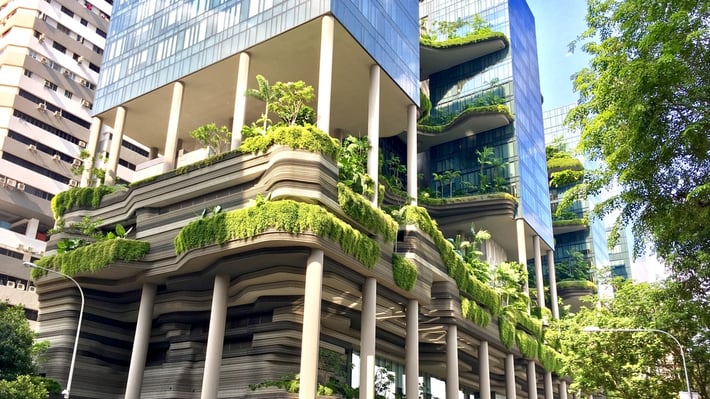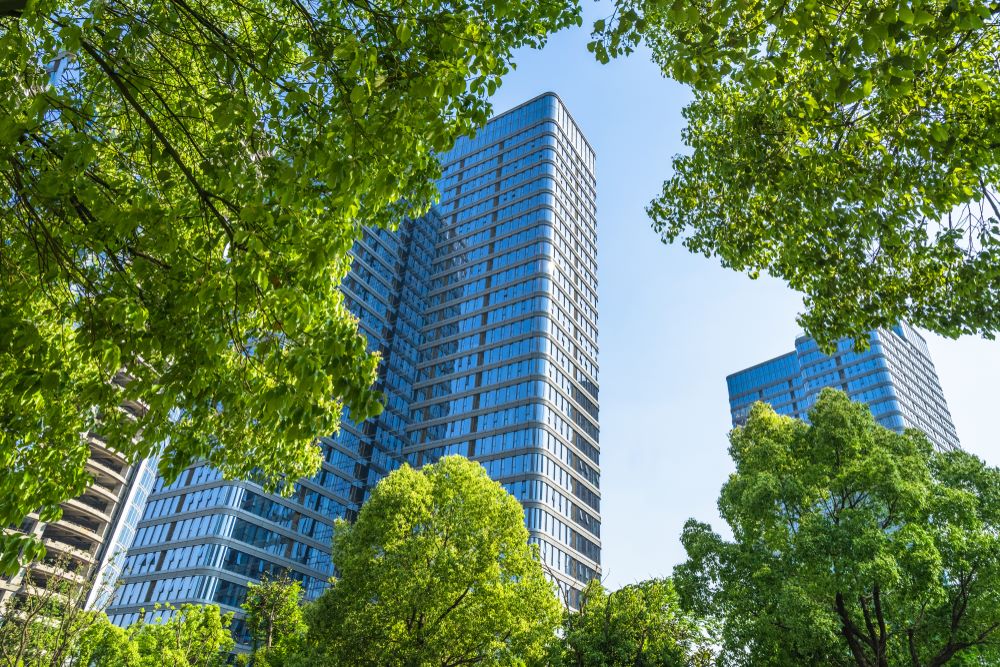Overview of the EDGE Certification for Buildings

EDGE is a green building certification system developed by the International Finance Corporation, which is part of the World Bank. EDGE stands for Excellence in Design for Greater Efficiencies, and the certification has the goal of reducing the environmental impact of buildings in three areas: direct energy consumption, water consumption, and the energy footprint of construction materials.
EDGE was developed by the IFC to address the environmental footprint of the building sector, focusing on emerging economies. Buildings are responsible for 19% of energy-related emissions globally, and they consume 40% of electricity. Considering that most power grids still depend on fossil fuels, electricity consumption has a major environmental impact. The building sector is expected to double by 2050, and most of the growth will occur in emerging countries.
Reduce your building's energy consumption, water consumption and carbon emissions.
The EDGE certification is currently available in 160 countries. By February 2020, EDGE buildings around the world were saving over 388 gigawatt-hours of energy per year, and over 10 million cubic meters of water per year. There were over 9.4 million certified square meters globally, preventing over 219,000 tons of carbon emissions per year.
How the EDGE Certification Works
As previously mentioned, the EDGE certification seeks to reduce the environmental impact of buildings in three areas: direct energy consumption, water consumption, and energy embodied in materials. EDGE has three certification levels for buildings, depending on how much the environmental impact is reduced. These levels are summarized in the table below:
|
EDGE Certification Level |
Requirements |
|
EDGE Certified |
20% reduction in energy consumption, water consumption, and energy embodied in materials. |
|
EDGE Advanced |
Same as EDGE Certified, with at least 40% reduction in energy consumption. |
|
Zero Carbon |
Same as EDGE Advanced, and the building must become carbon neutral by using 100% renewable energy and carbon offsets. |
To guide the process, the certification system includes a software package and a design standard.
The EDGE certification is an attractive option for existing buildings, since any materials installed at least five years ago are considered as having zero embodied energy. This makes one of the three requirements easier to meet, and building owners can focus on energy efficiency and water conservation.

EDGE can be applied more easily than LEED in existing buildings where there are no plans for a major renovation. With LEED, only the Operations & Maintenance (O+M) certification is available for existing buildings. LEED Building Design & Construction (BD+C) and LEED Interior Design & Construction (ID+C) are only usable in new constructions, or existing buildings that undergo major renovations.
Like LEED and WELL, the EDGE certification also includes two professional accreditation: EDGE Expert and EDGE Auditor. They are both involved in the certification process for buildings, with different roles.
The EDGE Certification Process
The EDGE certification is managed globally by two main organizations: Green Business Certification Inc. (GBCI) and the SGS-Thinkstep consortium. Depending on where a project is located, other organizations may be authorized to administer the EDGE certification locally. When a building gets the EDGE certification, there are three main parties involved in the process:
- The building owner’s design team, who identify the measures to achieve the reductions in energy consumption, water consumption, and embodied energy. The services of an EDGE Expert are strongly recommended, but not mandatory.
- An authorized certification body such as GBCI, SGS-Thinkstep, or another organization with local approval.
- An EDGE Auditor, who reviews the proposed measures and serves as a mediator between the project owner and the certification body.
The EDGE Auditor must be a neutral third party, which means the role cannot be assumed by someone who is part of the project staff. If a professional engineering firm is hired for project design, the EDGE Auditor cannot be part of that company either. In other words, the EDGE Auditor cannot be someone who has a conflict of interest in the project.

Cost of the EDGE Certification
Regardless of who provides the EDGE Certification, GBCI or SGS-thinkstep, there is an initial registration fee of $300. The fee is per project site and not per building, which means a site with multiple buildings does not become more expensive to register.
With respect to the certification itself, rates are different for GBCI and SGS-thinkstep. GBCI uses costs per square meter, which are summarized in the following table:
|
Building Size |
Cost per Square Meter |
Minimum Fee |
|
0 to 25,000 m2 |
$0.27 |
$2,500 |
|
25,000 to 50,000 m2 |
$0.22 |
$6,750 |
|
Over 50,000 m2 |
Not applicable |
$11,000 flat rate |
Note that GBCI also manages LEED and WELL building certifications.
SGS-thinkstep uses flat fees that change depending on project features. The following are “standard fees”, which are based on a residential project with up to 100 units and three dwelling types, or a commercial project with a single-end use:
- Certification: $2,400
- Design audit: $4,000
- Final audit: $4,000
- Total: $10,400
The EDGE Auditor fee does not charge a predetermined fee. Instead, the fee is negotiated directly between the project owner and the auditor.
Conclusion
EDGE is a green building certification with simpler requirements than LEED, while still achieving measurable results. The International Finance Corporation developed EDGE considering the needs of developing countries, where more complex certifications can be difficult to manage, especially if a country or region has not developed local expertise.

Michael Tobias
Michael Tobias, the Founding Principal of NY Engineers, currently leads a team of 150+ MEP/FP engineers and has led over 4,000 projects in the US
Join 15,000+ Fellow Architects and Contractors
Get expert engineering tips straight to your inbox. Subscribe to the NY Engineers Blog below.

